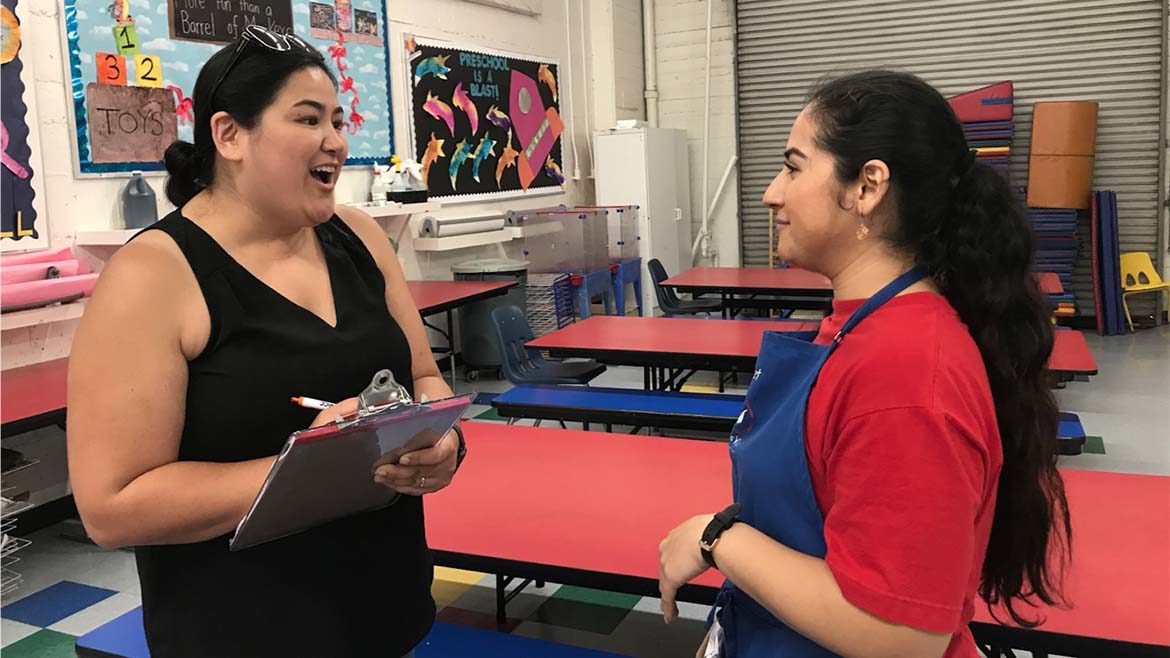Knight Foundation funds engagement project for public radio

SCPR
Ashley Alvarado of Southern California Public Radio interviews a preschool teacher in Pasadena, Calif.
Southern California Public Radio has received a $230,000 grant from the Knight Foundation to lead a yearlong community engagement project with a cohort of public radio stations.
The project aims to find ways of “connecting the pipes” between newsroom engagement projects and stations’ membership and development infrastructure, SCPR COO Kristen Muller told Current.
SCPR will develop a curriculum informed by Poynter’s Table Stakes, a 10-month program for assisting media outlets with transitioning to sustainable digital publishing. The curriculum will also be developed with input from participating stations Chicago Public Media, Minnesota Public Radio and WBUR in Boston. The American Press Institute will administer the program. “They’re going to be doing a lot of the work of getting everyone together, helping us with logistics,” Muller said.
The grant will go towards training, travel, and hiring coaches, who have not yet been identified. “We’re very hopeful that we can do a lot of this in person,” Muller said.
SCPR and participating stations will each assemble a cross-platform team to work on the project. Each team will include someone in editorial leadership, “someone who can affect change” on the development team, and ideally someone on the station’s product side, Muller said. Each team will be “running a bunch of tests” related to engagement that are specific to the station, she said.
“The goal is that we learn from each other a lot faster than if we’re all doing it separately,” Muller said.
Eventually, the teams will produce a playbook for public media that will provide insights into their findings for stations of all sizes, Muller said. She hopes to be able to share how engagement efforts can “both diversify audiences, reach new audiences, but also put them on a path to membership.”
The project has been “years in the making,” Muller said. SCPR has been putting a greater emphasis on community engagement in recent years, led by Ashley Alvarado, VP of community engagement and strategic initiatives. During the pandemic, thousands of people who don’t listen to radio asked SCPR questions related to the pandemic on its Hearken platform, according to Muller.
“We really saw the potential for this to scale,” said Muller. Half of the people whose questions were answered by the station signed up for a SCPR newsletter. “And the newsletter is, on the digital front, the fastest path to membership,” she said.
But SCPR has noticed back-end inefficiencies in its community engagement work. The organization communicates with audiences through more than a dozen systems, such as Salesforce and Hearken, “but none of those systems are synced up,” Muller said. “Hearken is not connected to our membership database — it’s still a manual process.”
SCPR conducts a lot of its community engagement work outside of traditional broadcast channels, but many of its systems are built to support the broadcast audience. “So for people that aren’t ever going to come in over the broadcast transom, how do we welcome them? How do we get them to feel like they’re part of a public media community?” Muller said.
SCPR reached out to WBUR over the summer to see whether the station would be interested in joining the cohort, said WBUR CCO Victor Hernandez. The project will require a big time commitment and draw on resources that WBUR could use elsewhere, Hernandez said, but the project is important because it’s an “investment not just in WBUR but … in sustainable journalism of the future. And so it’s absolutely worth exploring in every possible pursuit.”
Hernandez said he’s looking forward to addressing “internal silos” that can wall off editorial from other departments. He also wants to learn “why communities of color feel as though their stories aren’t being fairly and appropriately told.”
“How do we improve our listening techniques and understanding and being able to report with empathy?” he said.
Findings will be shared incrementally with the system throughout the year, Hernandez said.
“We are not going to sequester ourselves in a Zoom room or some corner and then a year from now, we’ll produce something and share it with the world or the industry,” he said. “We will have regular touchstones and talk about successes and failures and the breakthroughs.”






